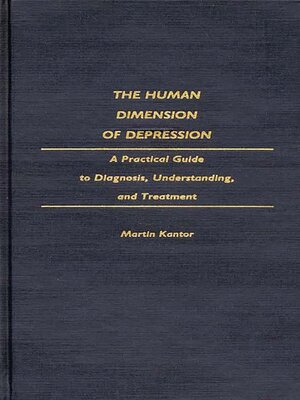The Human Dimension of Depression
ebook ∣ A Practical Guide to Diagnosis, Understanding, and Treatment
By Martin Kantor MD

Sign up to save your library
With an OverDrive account, you can save your favorite libraries for at-a-glance information about availability. Find out more about OverDrive accounts.
Find this title in Libby, the library reading app by OverDrive.



Search for a digital library with this title
Title found at these libraries:
| Loading... |
This book describes the depressive in his or her natural habitat, studies the everyday problems that cause one's depression, and develops treatment approaches directed to the depressive's real-world plight. It explores the borderland between the sacred and the profane, the academic and the popular, the scientific but impractical, and the practical but unscientific. It relies as much on common sense, anecdote, and individual insight as it does on case histories and psychological test protocol.
The book is divided into four sections: description, cause, prevention, and treatment. The descriptive section presents the mental-status abnormalities in depression, includes a differential diagnosis of classic depressive symptoms, indicates when so-called classic symptoms of another disorder are in fact depressive, lists the physical complaints that are the product of depression, discusses normal depression, and touches briefly on hypomania. The section on cause recognizes that real troubles are common and chemical troubles rare. It suggests that people do not get depressed because they are under stress or they have suffered loss, but, in simple language, because their boss has threatened to fire them, their wife has threatened to leave, the cat has died, and other similar real-life difficulties. It faces the problems that therapists and patients alike find unpalatable, shameful, and threatening—the things that cause patients to close their eyes or speak in remote euphemisms. The sections on prevention and therapy are not attached to any one school of thought. They are formulated and expressed simply and humanistically, and offer common-sense solutions to the depressives's everyday problems with themselves and their world.
The book is divided into four sections: description, cause, prevention, and treatment. The descriptive section presents the mental-status abnormalities in depression, includes a differential diagnosis of classic depressive symptoms, indicates when so-called classic symptoms of another disorder are in fact depressive, lists the physical complaints that are the product of depression, discusses normal depression, and touches briefly on hypomania. The section on cause recognizes that real troubles are common and chemical troubles rare. It suggests that people do not get depressed because they are under stress or they have suffered loss, but, in simple language, because their boss has threatened to fire them, their wife has threatened to leave, the cat has died, and other similar real-life difficulties. It faces the problems that therapists and patients alike find unpalatable, shameful, and threatening—the things that cause patients to close their eyes or speak in remote euphemisms. The sections on prevention and therapy are not attached to any one school of thought. They are formulated and expressed simply and humanistically, and offer common-sense solutions to the depressives's everyday problems with themselves and their world.






